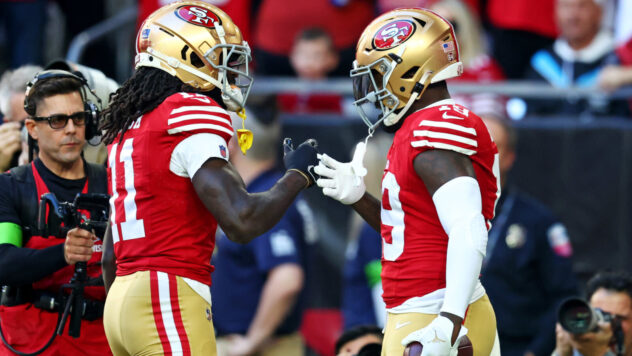‘60 Songs That Explain the ’90s’: The Rebirth of Cher, via Auto-Tune

“Believe” always sounded like the future—even today
60 Songs That Explain the ’90s is back for its final stretch run (and a brand-new book!). Join The Ringer’s Rob Harvilla as he treks through the soundtrack of his youth, one song (and embarrassing anecdote) at a time. Follow and listen for free on Spotify. In Episode 113 of 60 Songs That Explain the ’90s—yep, you read that right—we’re covering Cher’s “Believe.” Read an excerpt below.
We jump forward now to 1986. Put David Letterman on the list of people, the list of significant cultural entities who are still around today, still significant, still doing arguably good work, but they’ve changed so radically that it’s impossible now to convey what they were like back then. Another example here would be MTV—like, all of it, the whole channel, the whole universe of MTV, that station that just shows Ridiculousness reruns 23 and a half hours a day now? I cannot explain to a young person in 2024 how dominant MTV felt in 1986, in part because no young person will talk to me now.
But David Letterman—the jolly old harmless giant-bearded earnest guy who pops up every so often to interview George Clooney about his charity work or whatever—David Letterman in 1986 was an insurgent, terrifying, acidic, confrontational, revolutionary figure. As a youngish and radicalish late-night talk show host, Letterman was sometimes leading the revolution by putting on a Rice Krispies suit and submerging himself in a bowl of milk, and sometimes he was being a jerk to his guests, in those instances when he personally felt superior to his guests, which was always. And we loved David Letterman for this. Everyone did. Most people did. She didn’t.
Cher on David Letterman in 1986 is famous. This is a cataclysmic moment in her life, and in his life, and in the history of late-night talk shows. It probably mattered way more to him than to her, actually, come to think of it, and the cataclysm here is tough to fully convey given how much more swearing and confrontation you can find on TV now generally. Forget all that. Don’t mess with Cher. That’s the only real takeaway here.
There’s a look on Cher’s face immediately after she says this, right when the cheering starts and long before the booing starts, when Cher takes this deep breath and looks genuinely angry, and genuinely righteous in her anger, for just a second, and then it passes. And the cheering and booing stop, and David hams it up but also looks genuinely taken aback, and Cher clarifies that she just means that she can tell, watching the show, when David doesn’t like his guests. And David says, “I think a lot of people feel that way.” And then he asks her about her tattoos, and they talk pleasantly for 15 more minutes, and that’s it. That’s a famous TV moment, and when Letterman retires from late-night TV several decades later, Cher comes back and gives him a hug and calls him an asshole again, and it’s a legitimately heartwarming moment.
But what is conveyed, here, in the legitimately famous moment wherein Cher calls Letterman an asshole to his face on his show, is Cher’s willingness to speak truth to power and Cher’s ability to convey that she is way more powerful than whatever power she’s speaking truth to. All right. My wife is gonna get super salty with me if I don’t knock it off already and talk about Moonstruck.
Obviously I could’ve played you the more famous scene from the 1987 romantic dramedy classic Moonstruck, where Nicolas Cage says, “I’m in love with you” and Cher slaps the absolute bejesus out of him twice and says, “Snap out of it.” But you’ve seen that, you’ve heard that a billion times, right? Oh, let’s hear it again. Movie magic notwithstanding, listen to how loud these slaps are, dude. There are famous war movies less concussive than this shit.
Ow! Cher won the Oscar for Best Actress for her timeless portrayal of the super-charismatic Italian American lady who slaps the absolute bejesus out of Nicolas Cage in the 1987 classic Moonstruck. Cher’s not Italian, either, but, like, you tell her that. Sheesh. Cher is Armenian, FYI. At first I wasn’t going to bother mentioning that Cher was Armenian, but someone very close to this operation heard that I wasn’t going to mention that Cher was Armenian, and this person thought that my failure to tell you that Cher was Armenian was “pretty wack.” Which is rude, but I don’t want to be pretty wack. So: Cher is Armenian.
The great critic Lindsay Zoladz, who’s at The New York Times now, wrote a great piece for The Ringer in 2019 about Cher, about the 20th anniversary of the Cher song “Believe,” in fact. But this piece takes in the whole of Cher’s career, including the various iconic, flamboyant, delightfully fuck-you type dresses that Cher has worn, often to the Oscars (whether or not she was nominated), and often designed by the great Bob Mackie. Moonstruck is one of my wife’s favorite movies; when we lived in New York, my wife wanted to go see the Moonstruck house, where they filmed parts of Moonstruck in Brooklyn Heights. Amy Schumer owns the Moonstruck house now. What the fuck? My wife has two core memories involving Cher, and Moonstruck is one of them.
But so in this Ringer piece, Zoladz writes, “To understand the miracle of ‘Believe,’ you have to know how far Cher had fallen in the decade between Moonstruck and Auto-Tune.” In the late ’80s Cher contracted the Epstein-Barr virus. A major symptom is extreme fatigue, and she had to turn down a bunch of big movie rules, including, apparently, Thelma & Louise. Musically, Cher had better luck, in terms of maintaining her impact, and so it is time for me to ask you. Can you hear the hooting and hollering sailors, the Navy sailors, the crew of the U.S.S. Missouri, in the background here? I think you can hear them perfectly well, even if you can’t really hear them at all.
“I’d take back all the words that’d hurt you.” This song excerpt is also vexing to me, in terms of legally permissible length. Shit. Yes, yes. How do I talk about this without getting in trouble with either the Navy or my mother? The music video for Cher’s 1989 hit “If I Could Turn Back Time” consists of Cher prancing around on the deck of the U.S.S. Missouri amid hooting and hollering sailors in the U.S. Navy while wearing an outfit—Cher’s outfit, not the sailors’—that flaunts all of her tattoos. I forget the precise details, but I can still recall, I can still feel my mother’s profound disapproval, her revulsion, the first time she saw this video on MTV, which was also the first I saw the “If I Could Turn Back Time” video on MTV. I do not recommend that you and your mother find out about this video simultaneously.
Cher has a Top 40 hit with her cover of “The Shoop Shoop Song (It’s in His Kiss),” which appears in the 1990 film Mermaids, in which Cher stars as the mother of both Winona Ryder and Christina Ricci. That was a lot to absorb! This song also appears on Cher’s 1991 album, Love Hurts, on which Cher also covers “Love Hurts,” the song. Cher’s “Love Hurts” is the second-best version of “Love Hurts,” after the 1974 version by Nazareth, the butt-rock band. The Nazareth version of “Love Hurts” is still the best, obviously. Butt-rock is not a pejorative.
But OK: Perhaps more indicative of Cher’s whole deal in the ’90s, musically, is her 1995 album, It’s a Man’s World, which is, shall we say, adult contemporary. Cher had been hitting no. 1 on Billboard’s Adult Contemporary charts for a while—she had a couple of jams with Peter Cetera in the ’80s. Back in ’86, when Cher called Letterman an asshole, they also talked about Cher turning 40. (She was fine about turning 40 but not, like, excited about it. Relatable.) Now Cher was pushing 50. Now Cher was covering “Walking in Memphis.” (Pretty good.) Now Cher was covering fuckin’ Don Henley. (That’s even better, actually.) But Cher does not exactly come across as a cutting-edge pop superstar. It would be weird, I think, for Cher to be a cutting-edge pop superstar in the 1990s. Cher’s got some jams but knows her lane, and her lane in the 1990s is discovering fresh nuance in the line “Do I really feel the way I feel?”
Just as it’s nearly impossible for me to convey how dangerous Letterman felt in 1986 or how down bad Cher was in 1996, I don’t think I can truly express to you how jarring the words “can’t break through” sounded on the radio the first time you heard Cher robotically sing them. What just happened to Cher? In 2015 Cher told Billboard magazine, “The most fun I ever had making a song was ‘Believe.’ Because you didn’t know it was me in the beginning, and I was so excited.”
Who did this to Cher? Mark Taylor and Brian Rawling, two London-based producers, that’s who. And at first, when Taylor and Rawling were interviewed about what, precisely, they’d done to Cher, they lied about it. So. Per a 1999 New York Times piece about “Believe,” “Rob Dickins, president of London-based Warner Music U.K., had decided that the only thing Cher could do to make up for her last album, It’s a Man’s World, a set of rock ballads that sold disappointingly, was to focus on her gay audience with a high-energy dance record.” And then Cher said, ‘’He said, ‘I want you to make a dance album.’ I said I didn’t want to. But I have that problem: If someone says I want you to do something and I’m not sure, I usually just say I don’t want to do it.’”
To hear the full episode, click here. Subscribe here and check back every Wednesday for new episodes. And to order Rob’s new book, Songs That Explain the ’90s, visit the Hachette Book Group website.
















